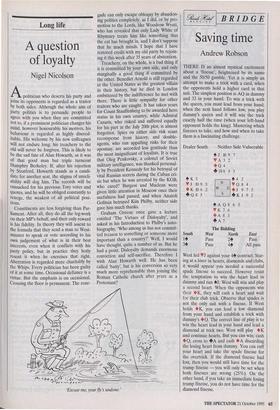X// BRIDGE
Saving time
Andrew Robson
THERE IS an almost mystical excitement about a 'finesse', heightened by its name and the 50/50 gamble. Yet it is simply an attempt to make a trick with a card, when the opponents hold a higher card in that suit. The simplest position is AQ in dummy and 32 in your hand. To win a trick with the queen, you must lead from your hand; when the next hand follows low, you play dummy's queen and it will win the trick exactly half the time (when your left-hand opponent holds the king). Mastering which finesses to take, and how and when to take them is a fascinating challenge.
Dealer South Neither Side Vulnerable
The Bidding
South West North East
14
Pass
24
Pass
34
Pass 44 All pass West led VJ against your 44 contract. Star- ing at a loser in hearts, diamonds and clubs, it would appear you needed a successful spade finesse to succeed. However resist the temptation to win the heart lead in dummy and run •J; West will win and play a second heart. When the opponents win their 4K, they will cash a heart and wait for their club trick. Observe that spades is not the only suit with a finesse. If West holds •K, you can lead a low diamond from your hand and establish a trick with dummy's *Q. The correct line of play is to win the heart lead in your hand and lead a diamond at trick two. West will play *IC and continue hearts. But you can win; cash 111Q; cross to +A and cash *A discarding the losing heart from dummy. You can ruff your heart and take the spade finesse for the overtrick. If the diamond finesse had lost, then you would still have time for the trump finesse — you will only be set when both finesses are wrong (25%). On the other hand, if you take an immediate losing trump finesse, you do not have time for the diamond finesse.










































































 Previous page
Previous page